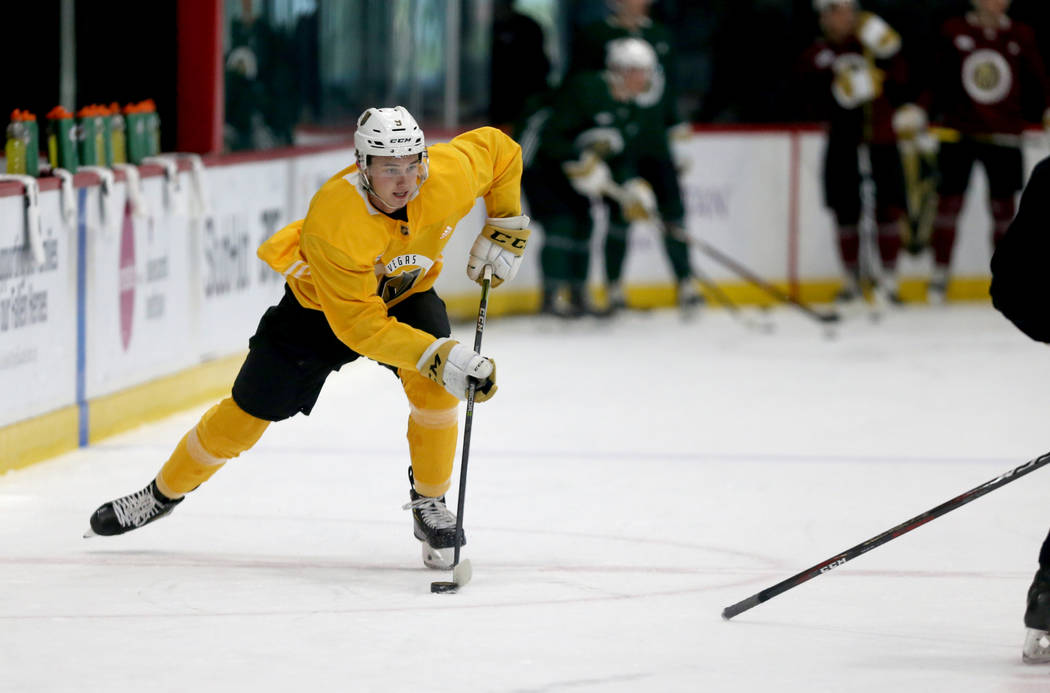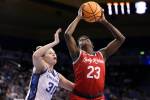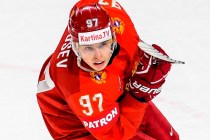Golden Knights take time developing top prospect Cody Glass








PORTLAND, Ore. — Cody Glass positioned the crutch in front of his body and leaned forward, waiting for the rest of his Portland Winterhawks teammates to exit the locker room at venerable Veterans Memorial Coliseum.
An unidentified teammate walked past and asked whether Glass was going to the Travis Scott concert that was about to begin next door at the Moda Center.
“Nah,” Glass responded.
The previous night, the Golden Knights prospect was involved in a scary play during Portland’s Western Hockey League game against rival Seattle.
Glass slid on his right knee in an effort to control a pass through the slot and ended up with Seattle forward Tyler Carpendale riding on his back.
The additional weight caused Glass’ left leg
to collapse into a pretzel underneath his body, and his left knee catapulted forward when Carpendale freed himself from the tangle of bodies.
Glass writhed in pain and was helped off the ice, but an MRI later showed no major damage to Glass’ knee, according to Knights general manager George McPhee. He is officially listed on the WHL weekly report as day to day with a lower-body injury.
The crutch, along with the knee brace under his slacks, help explain why Glass stayed behind while several of the Winterhawks went to hear Scott perform “Sicko Mode.”
He probably would have skipped the show regardless.
“He’s a pretty mature kid for 19 years old,” said Brian Facchini, one of Glass’ host parents. “Handles himself really well, and you can tell that he’s taking this seriously as a profession, even at the major-junior level.”
In this era of instant gratification, and as the NHL grows increasingly younger — nine of the league’s top 10 scorers are age 25 or under — Glass remains in the same place he’s been for most of the past four years.
The Knights avoided the temptation to rush the No. 6 overall pick from the 2017 NHL draft, and he continues to develop at his own rate here in the Pacific Northwest.
“The one thing we’ve learned over the years is it never hurts a player to spend more time at the amateur level or the American league level,” McPhee said. “Overcooking the player never hurts that player. What does hurt a player, what can stunt development and maybe preclude a player from getting to the highest level he should be at is playing them too young.”
Age issue
The Knights didn’t have a choice in Glass’ destination this season after he was cut from training camp.
The NHL and Canadian Hockey League, which oversees the three major-junior leagues, have an agreement that prohibits 18- and 19-year-olds from playing in the AHL, forcing Glass back to Portland.
The major-junior route, which also includes the Ontario Hockey League and Quebec Major Junior Hockey League, differs from college or professional hockey in several aspects.
For instance, Glass attended Sunset High School in Beaverton, Oregon, for two years starting at age 16 until graduation. And rather than being on his own, he lives with a host family, as do all his Winterhawks teammates.
Glass stayed with the same family for three years before moving in with Facchini his wife, Summer, and their two children. He is joined in the house by Sharks prospect Joachim Blichfeld and Hurricanes draft pick Brendan De Jong.
“I don’t know other programs, but they don’t have the luxury of sleeping in late and just go to practice and then, you know, go hit some golf balls and come home and put their feet up,” Facchini said. “In their last year after they’ve been drafted, I think they really are learning to manage a more adult schedule.”
Glass, who turns 20 on April 1, signed an entry-level contract with the Knights and received a signing bonus but does not get paid by the Winterhawks or WHL. He said players are reimbursed up to $250 for monthly expenses.
Unlike fellow Knights 2017 draft picks Erik Brannstrom and Nicolas Hague, who make a $70,000 salary in the American Hockey League, Glass rides a bus to all his games.
“For me, I feel like I wanted to play pro this year just because I wanted a taste of it, even if that was in the AHL, just to play against men for a year,” Glass said. “Obviously, that would prepare me for the NHL level. But, the situation how it is, I just have to come back here, and obviously I wanted to dominate. That’s just what I’ve been focusing on.”
By returning to Portland, Glass lines up against players that range in age from 15 to 20, or in some cases 21. In the Winterhawks’ 3-0 victory that Glass missed Sunday, visiting Lethbridge gave regular ice time to 15-year-old winger Zack Stringer.
But the extra season in junior also allows Glass to serve as captain for the Winterhawks and play on all special teams, which he might not do if he was playing pro.
The Knights’ meticulous development plan contrasts with a team such as Edmonton, which tried to develop 2016 No. 4 overall pick Jesse Puljujarvi at the NHL level with mixed results.
The Islanders’ Mathew Barzal, the most recent recipient of the Calder Trophy as rookie of the year, is an example of a player who benefited from an additional season in junior.
“I personally believe leaving them in junior to play as a 19-year-old is positive,” said Winterhawks coach Mike Johnston, who coached the Pittsburgh Penguins for 110 games from 2014 to 2015. “If Cody gets to the NHL and he turns into a checker and loses his offensive ability, he’s not going to be as effective a player. You want him to be the 200-foot player that he is here, that can do a little bit of everything for you.”
Shot to make Knights roster
Glass’ experience playing at the World Junior Championship in December was another key step in his development, according to McPhee.
The 6-foot-2-inch, 185-pounder showed his improved strength and skating as the No. 1 center for Canada and finished with two goals and four assists in five games.
“Cody as a young guy was very light as a player, got knocked off pucks. The pace of his game was slower,” Johnston said. “But you could always see the hockey IQ there, and I think over time he’s really worked on his physical development.”
In 34 games with Portland, Glass is second in the WHL with 51 assists and has 13 goals. His 1.88 points per game leads the league, ahead of 20-year-old linemate Joachim Blichfeld (1.81).
Glass had 102 points (37 goals, 65 points) in 64 games with the Winterhawks last season.
That consistency is one of the indicators McPhee is looking for to determine whether Glass is ready for the next level.
Once the Winterhawks’ season ends, Glass is eligible to play up to nine NHL games without burning the first year of his entry-level contract. Otherwise, McPhee expects he will challenge for a roster spot in training camp next season.
“Obviously, we’ll monitor everything he’s done to date and with any player say, ‘OK what is the best place for this player?’ ” McPhee said. “You want to have the flexibility to be able to bring people up when they’re ready to come up.”
The danger at this stage is to compare Glass to his draft peers. Vancouver’s Elias Pettersson, who went one pick before Glass, is the favorite for rookie of the year.
He’s also five months older than Glass and further along in his development.
Glass understands he is on a different path, one that brought him back to Portland for another year.
“Obviously being a top-10 pick, you want to be in the NHL,” Glass said. “That’s something I really wanted going into this year, but I think you’ve just got to take your time with it. Everybody has their timetable. It’s just when it starts and when you get that opportunity, you just need to run with it.”
More Golden Knights: Follow at reviewjournal.com/GoldenKnights and @HockeyinVegas on Twitter.
Contact David Schoen at dschoen@reviewjournal.com or 702-387-5203. Follow @DavidSchoenLVRJ on Twitter.
Cody Glass
Born: April 1, 1999
Birthplace: Winnipeg, Manitoba
Position: Center
Shoots: Right
Draft: 2017, 1st round (6th overall)
2018-19 stats: 13 goals, 51 assists, 64 points in 34 games for Portland Winterhawks (WHL)



















